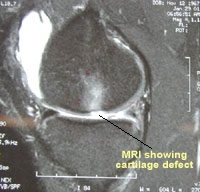|

 How
is articular cartilage damage diagnosed? How
is articular cartilage damage diagnosed?
It can be difficult to diagnose an articular cartilage injury.
Physical examination may show a swollen knee, but frequently
the exam is normal.
Imaging may help the doctor make a diagnosis in some, but
not all, cases. X-rays may be normal in most cases because
only bone damage is visible on X-ray. One indication of
advanced cartilage loss is a decrease in space between two
bone surfaces. A loose bone fragment may be detected in
a condition called osteochondritis dissecans
(OCD), in which a portion of bone detaches with the
articular cartilage.
An MRI (Magnetic Resonance Image) may reveal softened
cartilage in many cases. This softening can be difficult to
detect, however, and the diagnosis may require the most sensitive
and highest quality MRI images, which may show changes in
the underlying bone. Cartilage thinning or loss is also usually
visible on MRI.
Articular cartilage damage is
most reliably diagnosed with an arthroscopic examination
of the joint. In this procedure, a tiny fiberoptic scope is
inserted into the joint. The doctor uses this scope to visually
assess the damage.
|
 
© 2015 by LeadingMD.com All rights reserved.
|
|
|
Stem cells, PRP, and HA, oh my! We are not in Kansas anymore… Part 2
READ MORE >>
|
|
|
|
